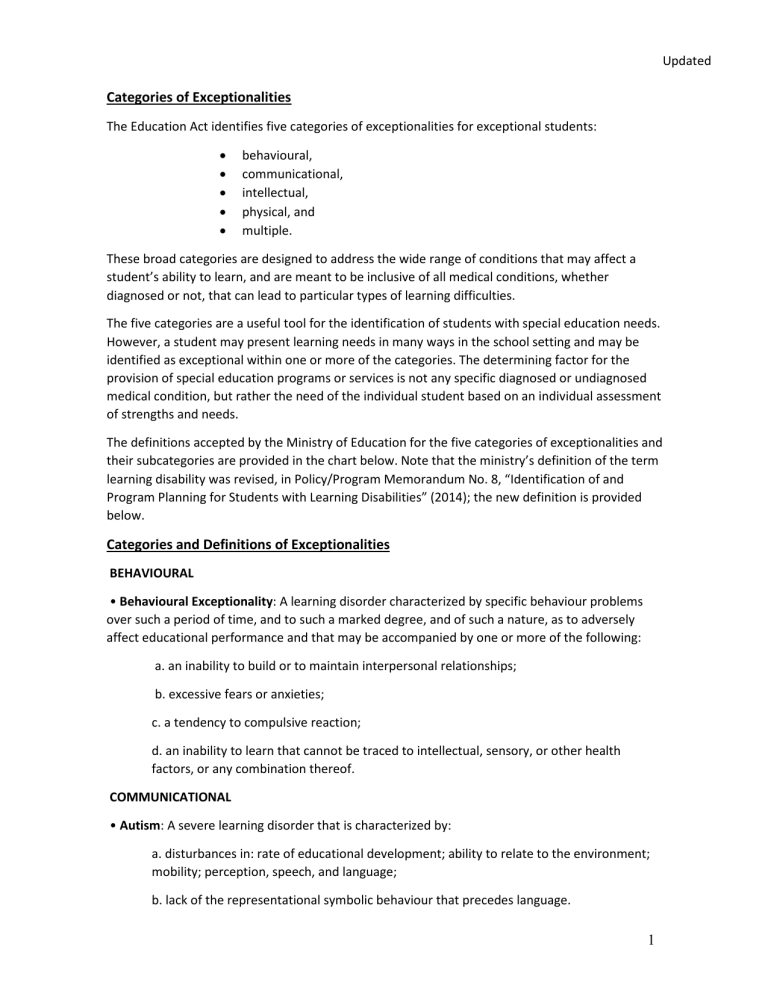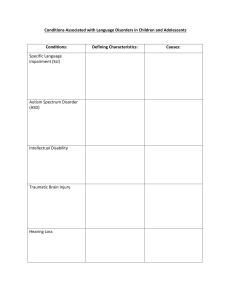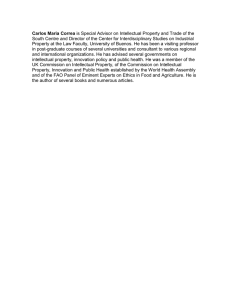
Updated Categories of Exceptionalities The Education Act identifies five categories of exceptionalities for exceptional students: • • • • • behavioural, communicational, intellectual, physical, and multiple. These broad categories are designed to address the wide range of conditions that may affect a student’s ability to learn, and are meant to be inclusive of all medical conditions, whether diagnosed or not, that can lead to particular types of learning difficulties. The five categories are a useful tool for the identification of students with special education needs. However, a student may present learning needs in many ways in the school setting and may be identified as exceptional within one or more of the categories. The determining factor for the provision of special education programs or services is not any specific diagnosed or undiagnosed medical condition, but rather the need of the individual student based on an individual assessment of strengths and needs. The definitions accepted by the Ministry of Education for the five categories of exceptionalities and their subcategories are provided in the chart below. Note that the ministry’s definition of the term learning disability was revised, in Policy/Program Memorandum No. 8, “Identification of and Program Planning for Students with Learning Disabilities” (2014); the new definition is provided below. Categories and Definitions of Exceptionalities BEHAVIOURAL • Behavioural Exceptionality: A learning disorder characterized by specific behaviour problems over such a period of time, and to such a marked degree, and of such a nature, as to adversely affect educational performance and that may be accompanied by one or more of the following: a. an inability to build or to maintain interpersonal relationships; b. excessive fears or anxieties; c. a tendency to compulsive reaction; d. an inability to learn that cannot be traced to intellectual, sensory, or other health factors, or any combination thereof. COMMUNICATIONAL • Autism: A severe learning disorder that is characterized by: a. disturbances in: rate of educational development; ability to relate to the environment; mobility; perception, speech, and language; b. lack of the representational symbolic behaviour that precedes language. 1 • Deaf and Hard of Hearing: An impairment characterized by deficits in language and speech development because of a diminished or non-existent auditory response to sound. • Language Impairment: A learning disorder characterized by an impairment in comprehension and/or the use of verbal communication or the written or other symbol system of communication, which may be associated with neurological, psychological, physical, or sensory factors, and which may: a. involve one or more of the form, content, and function of language in communication; and b. include one or more of: language delay; dysfluency; voice and articulation development, which may or may not be organically or functionally based. • Speech Impairment: A disorder in language formulation that may be associated with neurological, psychological, physical, or sensory factors; that involves perceptual motor aspects of transmitting oral messages; and that may be characterized by impairment in articulation, rhythm, and stress. • Learning Disability: One of a number of neurodevelopmental disorders that persistently and significantly has an impact on the ability to learn and use academic and other skills and that: a. affects the ability to perceive or process verbal or non-verbal information in an effective and accurate manner in students who have assessed intellectual abilities that are at least in the average range; b. results in (a) academic underachievement that is inconsistent with the intellectual abilities of the student (which are at least in the average range), and/or (b) academic achievement that can be maintained by the student only with extremely high levels of effort and/or with additional support; c. results in difficulties in the development and use of skills in one or more of the following areas: reading, writing, mathematics, and work habits and learning skills; d. may typically be associated with difficulties in one or more cognitive processes, such as phonological processing; memory and attention; processing speed; perceptual motor processing; visual-spatial processing; executive functions (e.g., self-regulation of behaviour and emotions, planning, organizing of thoughts and activities, prioritizing, decision making); e. may be associated with difficulties in social interaction (e.g., difficulty in understanding social norms or the point of view of others); with various other conditions or disorders, diagnosed or undiagnosed; or with other exceptionalities; f. is not the result of a lack of acuity in hearing and/or vision that has not been corrected; intellectual disabilities; socio-economic factors; cultural differences; lack of proficiency in the language of instruction; lack of motivation or effort; gaps in school attendance or inadequate opportunity to benefit from instruction. 2 INTELLECTUAL • Giftedness: An unusually advanced degree of general intellectual ability that requires differentiated learning experiences of a depth and breadth beyond those normally provided in the regular school program to satisfy the level of educational potential indicated. • Mild Intellectual Disability: A learning disorder characterized by: a. an ability to profit educationally within a regular class with the aid of considerable curriculum modification and support services; b. an inability to profit educationally within a regular class because of slow intellectual development; c. a potential for academic learning, independent social adjustment, and economic self support. • Developmental Disability: A severe learning disorder characterized by: a. an inability to profit from a special education program for students with mild intellectual disabilities because of slow intellectual development; b. an ability to profit from a special education program that is designed to accommodate slow intellectual development; c. a limited potential for academic learning, independent social adjustment, and economic self-support. PHYSICAL • Physical Disability: A condition of such severe physical limitation or deficiency as to require special assistance in learning situations to provide the opportunity for educational achievement equivalent to that of students without exceptionalities who are of the same age or development level. • Blind and Low Vision: A condition of partial or total impairment of sight or vision that even with correction affects educational performance adversely. M U LT I P L E • Multiple Exceptionalities: A combination of learning or other disorders, impairments, or physical disabilities that is of such a nature as to require, for educational achievement, the services of one or more teachers holding qualifications in special education and the provision of support services appropriate for such disorders, impairments, or disabilities. 3 OLD -Categories of exceptionalities in Ontario The following are the five categories of exceptionality recognized by the province of Ontario and used in Identification Placement and Review Committees. There may be some flexibility within the categories for the purposes of identifying a student as “exceptional” under the Ministry definition. 1. 2. 3. 4. 5. behaviour communication intellectual physical multiple These broad categories include the following definitions: 1. Behaviour A learning disorder characterized by specific behaviour problems over such a period of time, and to such a marked degree, and of such a nature, as to adversely affect educational performance, and that may be accompanied by one or more of the following: • an inability to build or to maintain interpersonal relationships; • excessive fears or anxieties; • a tendency to compulsive reaction; • an inability to learn that cannot be traced to intellectual, sensory, or • other health factors, or any combination thereof. 2. Communication Autism A severe learning disorder that is characterized by: • disturbances in: o rate of educational development; o ability to relate to the environment; o mobility; o perception, speech, and language; lack of the representational symbolic • behaviour that precedes language. Deaf and Hard-of-Hearing An impairment characterized by deficits in language and speech development because of a diminished or non-existent auditory response to sound. 4 Language Impairment A learning disorder characterized by an impairment in comprehension and/or the use of verbal communication or the written or other symbol system of communication, which may be associated with neurological, psychological, physical, or sensory factors, and which may: • involve one or more of the form, content, and function of language in communication; and • include one or more of: o language delay; o dysfluency; o voice and articulation development, which may or may not be organically or functionally based. Speech Impairment A disorder in language formulation that may be associated with neurological, psychological, physical, or sensory factors; that involves perceptual motor aspects of transmitting oral messages; and that may be characterized by impairment in articulation, rhythm, and stress. Learning Disability A learning disorder evident in both academic and social situations that involves one or more of the processes necessary for the proper use of spoken language or the symbols of communication, and that is characterized by a condition that: • is not primarily the result of: o impairment of vision; o impairment of hearing; o physical disability; o developmental disability; o primary emotional disturbance; o cultural difference; • results in a significant discrepancy between academic achievement and assessed intellectual ability, with deficits in one or more of the following: o receptive language (listening, reading); o language processing (thinking, conceptualizing, integrating); o expressive language (talking, spelling, writing); o mathematical computations; and • may be associated with one or more conditions diagnosed as: o a perceptual handicap; o a brain injury; o minimal brain dysfunction; o dyslexia; o developmental aphasia. 5 3. Intellectual Giftedness An unusually advanced degree of general intellectual ability that requires differentiated learning experiences of a depth and breadth beyond those normally provided in the regular school program to satisfy the level of educational potential indicated. Mild Intellectual Disability A learning disorder characterized by: • an ability to profit educationally within a regular class with the aid of considerable curriculum modification and supportive service; • an inability to profit educationally within a regular class because of slow intellectual development; • a potential for academic learning, independent social adjustment, and economic self-support. Developmental Disability A severe learning disorder characterized by: • an inability to profit from a special education program for students with mild intellectual disabilities because of slow intellectual development; • an ability to profit from a special education program that is designed to accommodate slow intellectual development; • a limited potential for academic learning, independent social adjustment, and economic self-support. 4. Physical Physical Disability A condition of such severe physical limitation or deficiency as to require special assistance in learning situations to provide the opportunity for educational achievement equivalent to that of pupils without exceptionalities who are of the same age or development level. Blind and Low Vision A condition of partial or total impairment of sight or vision that even with correction affects educational performance adversely. 5. Multiple Multiple Exceptionalities A combination of learning or other disorders, impairments, or physical disabilities that is of such a nature as to require, for educational achievement, the services of one or more teachers holding qualifications in special education and the provision of support services appropriate for such disorders, impairments, or disabilities. 6




